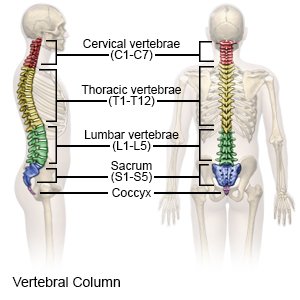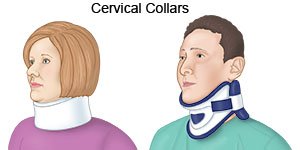Spasmodic Torticollis
Medically reviewed by Drugs.com. Last updated on Sep 23, 2025.
What is spasmodic torticollis?
Spasmodic torticollis is a condition that causes your neck muscles to contract (shorten and tighten). Your neck twists suddenly and causes your head to tilt or turn without control. You may have trouble moving your neck. You may also have headaches, neck pain, or shoulder pain. Your neck muscles may have spasms, stiffness, or swelling. Symptoms often gets worse with stress, sudden movement, or muscle strain. Spasmodic torticollis is also called cervical dystonia.
 |
What causes spasmodic torticollis?
The exact cause of spasmodic torticollis is not known. You may have been born with the condition. Torticollis may happen after an injury to your cervical spine. It may also be caused by a medical condition that affects your muscles, bones, nervous system, eyes, or balance. Your risk may be higher if you have a family history of spasmodic torticollis.
How is spasmodic torticollis diagnosed?
Your healthcare provider will examine your head and neck. You may also need any of the following:
- X-ray, CT scan, or MRI pictures may be used to look for problems in your bones, muscles, brain, or blood vessels. You may be given contrast liquid to help the pictures show up better. Tell your healthcare provider if you have ever had an allergic reaction to contrast liquid. The MRI machine uses a powerful magnet. Do not enter the MRI room with anything metal. Metal can cause serious injury from the magnet. Tell the healthcare provider if you have any metal in or on your body.
- Electromyography (EMG) is done to test your muscles and the nerves that control them. Electrodes (wires) are placed on the area of muscle being tested. Needles that enter your skin may be attached to the electrodes. The electrical activity of your muscles and nerves is measured by a machine attached to the electrodes. Your muscles are tested at rest and with activity.
How is spasmodic torticollis treated?
- Medicines:
- Muscle relaxers decrease pain and muscle spasms.
- Botulinum toxin injections may be given to relax your muscles.
- NSAIDs , such as ibuprofen, help decrease swelling, pain, and fever. This medicine is available with or without a doctor's order. NSAIDs can cause stomach bleeding or kidney problems in certain people. If you take blood thinner medicine, always ask if NSAIDs are safe for you. Always read the medicine label and follow directions. Do not give these medicines to children younger than 6 months without direction from a healthcare provider.
- Acetaminophen decreases pain and fever. It is available without a doctor's order. Ask how much to take and how often to take it. Follow directions. Read the labels of all other medicines you are using to see if they also contain acetaminophen, or ask your doctor or pharmacist. Acetaminophen can cause liver damage if not taken correctly.
- Prescription pain medicine may be given. Ask your healthcare provider how to take this medicine safely. Some prescription pain medicines contain acetaminophen. Do not take other medicines that contain acetaminophen without talking to your healthcare provider. Too much acetaminophen may cause liver damage. Prescription pain medicine may cause constipation. Ask your healthcare provider how to prevent or treat constipation.
- Surgery may be used to cut the nerves that supply the affected muscles, or to separate the muscles.
Treatment options
The following list of medications are related to or used in the treatment of this condition.
What can I to do manage my symptoms?
- Rest as needed. Return to your daily activities as directed.
- Apply ice to decrease swelling and pain. Apply ice on your neck for 15 to 20 minutes every hour or as directed. Use an ice pack, or put crushed ice in a plastic bag. Cover the bag with a towel before you apply it. Apply ice for as many days as directed.
- Apply heat to decrease pain and muscle spasms. Apply heat on your neck for 20 to 30 minutes every 2 hours, or as directed. Use a heat pack or a heating pad set on low. Apply heat for as many days as directed.
- Wear a cervical collar as directed. A cervical collar helps support your neck.

Call your local emergency number (911 in the US) if:
- You have sudden shortness of breath.
- You have trouble moving your arms or legs.
- Your arms or legs feel numb.
When should I seek immediate care?
- You have increased pain in your neck or shoulder.
When should I call my doctor?
- You have a fever.
- You have swelling in your neck area that gets worse or does not go away.
- You have questions or concerns about your condition or care.
Care Agreement
You have the right to help plan your care. Learn about your health condition and how it may be treated. Discuss treatment options with your healthcare providers to decide what care you want to receive. You always have the right to refuse treatment. The above information is an educational aid only. It is not intended as medical advice for individual conditions or treatments. Talk to your doctor, nurse or pharmacist before following any medical regimen to see if it is safe and effective for you.© Copyright Merative 2025 Information is for End User's use only and may not be sold, redistributed or otherwise used for commercial purposes.
Learn more about Spasmodic Torticollis
Treatment options
Further information
Always consult your healthcare provider to ensure the information displayed on this page applies to your personal circumstances.
